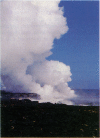Abstract
We made environmental measurements to characterize contaminants generated when basaltic lava from Hawaii's Kilauea volcano enters sea water. This interaction of lava with sea water produces large clouds of mist (LAZE). Island winds occasionally directed the LAZE toward the adjacent village of Kalapana and the Hawaii Volcanos National Park, creating health concerns. Environmental samples were taken to measure airborne concentrations of respirable dust, crystalline silica and other mineral compounds, fibers, trace metals, inorganic acids, and organic and inorganic gases. The LAZE contained quantifiable concentrations of hydrochloric acid (HCl) and hydrofluoric acid (HF); HCl was predominant. HCl and HF concentrations were highest in dense plumes of LAZE near the sea. The HCl concentration at this sampling location averaged 7.1 ppm; this exceeds the current occupational exposure ceiling of 5 ppm. HF was detected in nearly half the samples, but all concentrations were <1 ppm Sulfur dioxide was detected in one of four short-term indicator tube samples at approximately 1.5 ppm. Airborne particulates were composed largely of chloride salts (predominantly sodium chloride). Crystalline silica concentrations were below detectable limits, less than approximately 0.03 mg/m3 of air. Settled dust samples showed a predominance of glass flakes and glass fibers. Airborne fibers were detected at quantifiable levels in 1 of 11 samples. These fibers were composed largely of hydrated calcium sulfate. These findings suggest that individuals should avoid concentrated plumes of LAZE near its origin to prevent over exposure to inorganic acids, specifically HCl.
Full text
PDF




Images in this article
Selected References
These references are in PubMed. This may not be the complete list of references from this article.
- Oakes D., Douglas R., Knight K., Wusteman M., McDonald J. C. Respiratory effects of prolonged exposure to gypsum dust. Ann Occup Hyg. 1982;26(1-4):833–840. [PubMed] [Google Scholar]









